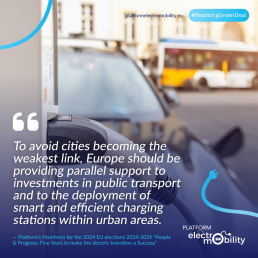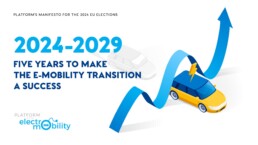Recommendations for the deployment of sustainable infrastructure of BE HDVs
28th November 2023PublicationsLogistic,Infrastructure
Logistics & Infrastructures
Driving the adoption of Battery Electric Heavy-Duty Vehicles
General policy recommendations for the deployment of sustainable infrastructure
The members of the Platform for electromobility recognise the importance of driving uptake of the required infrastructures for Battery Electric Trucks and buses (BEHDVs). They also recognise the need for policy recommendations that complement the Alternative Fuels Infrastructure Regulation (AFIR) and Energy Performance of Buildings Directive (EPBD).
The challenges in this area span multiple sectors, from energy, through land management and on to data security. We therefore emphasise the importance of cooperation between all sectors of the electric road transport system, resulting in this paper, which outlines the key elements that legislators should keep in mind when addressing this topic.
In this position paper, we identify three areas that require attention and provide policy recommendations to ensure the successful roll out of infrastructures for BEHDVs: the grid, the data framework and the land.
Beyond infrastructure (which this paper is dedicated to), we stress the importance of ambitious, clear and timely revision of both the CO2 Standards for trucks and buses Regulation and the Weights and Dimensions Directive. We have discussed both of these in previous publications (respectively here and here).
The grid

A. Assessments: per country and per usage
While strong CO2 Standards would prove useful for anticipating actual and future demand, a situation where a grid connection may not be available can potentially undermine the trajectory defined by those new CO2 Standards. It therefore becomes urgent to immediately and proactively assess whether there is sufficient potential grid-capacity to allow for sufficient connection for the charging infrastructure needed for BEHDVs. Assessment becomes all the more pressing when considering the lengthy lead times, the need for grid reinforcement, the likely demand for BEHDVs and the number of actors involved.
Grid infrastructure varies between countries. Some may need important investments in order to prepare for the integration of BEHDVs, with the development of megafast chargers where required. In the Netherlands – a European Member State at the forefront of road transport electrification (along with other such as Germany and, to a lesser extent, Belgium) – it appears to be extremely difficult for transport operators to obtain the needed capacity for BEHDVs, both at their depots and on the road, due to a lack of effective planning. Even where capacity increases are possible, long delays for connection and procedural constraints present barriers to the swift adoption of BEHDVs.
Grid infrastructure varies between usages. While large charging hubs for BEHDVs along motorways will be the exception and the depot/destination charging overnight the rule, the need for very high-level connection capacity along the motorway should be tackled. Medium- and high-voltage connections to the power grid will be necessary to support the fast charging times in the event of opportunity charging. To deliver the necessary power capacity, grid strengthening may be required at both public locations and – for different reasons – at private charging depots/distribution centres.
BEHDVs-suitable charging locations can be mapped and the power needs for those locations assessed. Recent existing mapping[1] – based on the GPS records of large numbers of trucks routes during one year throughout Europe – can provide a good starting point. Truck stakeholders can subsequently confirm or propose new locations for the recharging infrastructure and the power required. Distribution System Operators (DSOs) and Transmission System Operators (TSOs) should confirm whether there is sufficient capacity and, where necessary, propose alternatives.
We would welcome support for undertaking a similar mapping exercise for coaches and interurban buses. Such analysis would also support the task forces (see below) in deciding the pre-equipment needed for depots and distribution centres, as well for existing service stations. This would ensure that delays in installing charging stations for BEHDVs do not exceed reasonable timescales.
Mapping analysis shows some 10% of locations will account for half the opportunity charging stops.[2] Pre-identifying these would help accelerate the coordinated development of charging infrastructure for BEHDVs and facilitate discussion within the dedicated task forces.
B. Task Forces
The task forces – constituted as follows – should be established and moderated by transport ministries or designated government agencies. National task forces: DSOs or their representations; TSOs; manufacturers of BEHDVs, BEHDVs operators and national associations[3]; representations of energy aggregators operators; fleet managers; road and urban planners; national Charging Point Operator (CPOs) associations.
Such task forces would be well suited for indicating the investments required to extend and reinforce charging infrastructure and to determine suitable charging locations and power requirements. This will enable DSOs and TSOs to plan the necessary grid extensions and reinforcements. This is extremely important for those areas that are not being developed by project developers due to high investment costs and long lead times for grid connections. The bottom line for achieving a comprehensive approach to planning involves early engagement with fleet managers, road operators, local municipalities, CPOs and grid utilities. Such an approach helps in proactively addressing public acceptance, potential land use challenges and in establishing a workable and timely power delivery schedule.
C. National deployment plans
In order to forge a stronger link between the AFIR implementation and the deployment of charging infrastructure for BEHDVs, we propose that Member States base their own national deployment plans on the AFIR targets, reflecting the anticipated demand at each location.
These plans should align with the anticipated demand for BEHDV charging, while also considering such factors as traffic density and projected growth in BEHDV usage and stops. By adopting such an approach, Member States can provide network operators and other stakeholders with longer lead times for planning future infrastructure uptake and anticipated connection requests, particularly post-2030.
D. Public & private investments
A high-capacity grid does not come without costs. Ultrafast charging stations are expected to require large MVA network connections, which usually occur directly at high voltage level but can also occur at MV level, depending on Member State specificities.
Well-designed European financing programmes can attract private investments for BEHDV infrastructure development. To facilitate implementation, and considering the high CapEx involved, public funding should be made available: The Connecting European Facility (CEF) is a vast programme, one that is primarily focused on passenger cars rather than on BEHDVs. This limits its alignment with the needs of the heavy-duty vehicle sector. Typically, the Alternative Fuels Infrastructure Facility (AFIF) Call of the CEF Programme supports BEHDVs infrastructure between 150kW and 350kW while for 800kW and higher, power the financial solutions provided by European Commission are too limited. The annex should be adapted to better take account of the needs of BEHDVs.
2. The Data Framework

A. Align grid codes, regulations to ultrahigh-power charging standards under development
The introduction of ultrahigh power charging standards necessitates global and European recognition. When being designed, standards should take into account factors such as space and interoperability as well as the futureproofing of those ultrahigh power charging standards currently under development. Any existing regulations that did not anticipate BEHDVs and their charging infrastructure must be updated to in order to accommodate this new paradigm. Definitions of technical aspects and use cases must be integrated into existing technical codes and regulations. Temporary exceptions will likely be required in areas such as standardised and certified energy metering concepts, which are currently lacking for megawatt charging. Member States should implement standards for BEHDV infrastructures for both public and private applications. Last, it is not possible to apply to EU funding for deployment of standards that have yet to be adopted.
B. Harness the flexibility potential of BEHDVs
Smart and bidirectional charging can be key in increasing the uptake of renewable energy and in offering flexibility potential to the grid. While initially this may seem challenging to implement, given the fast-charging requirements dictated by the road transport business model based on opportunity charging. Yet, the potential to harness the flexibility of the BEHDVs is actually significant, particularly considering their battery sizes, the high predictability of their routes and time schedules and the predominance of depot/overnight charging.
Smart energy management systems can therefore be deployed, specifically through the implementation of balancing mechanisms between connectors. This will synchronise with renewable energy production and provide a fast-frequency response to keep the grid stable. This would further require signals to use the flexibility from batteries, such as incentives for aggregators and dynamic tariffs, etc. Beyond advanced planning, tariffication incentives and financial incentives in the grid services markets are other crucial elements for minimising grid impact and allowing potential grid balancing.
Bidirectional and smart charging can be particularly suitable for certain business models, notably buses and trucks that are not operated on a 24/7 basis (short-haul and regional transport). Their large batteries can offer key services to the grid. Smart meters should be considered as one of the solutions for smart charging in depots and distribution centres. However, regulatory frameworks will need to be adapted in order to enable bidirectional charging and provide economic incentives.
Finally, the sector is currently exploring the potential of flexible storage positions within local energy systems, such as incorporating stationary batteries into charging stations or exploring battery swapping solutions. Such approaches can help reduce the strain on the grid, offering advantages to both charging operators and system operators by enhancing flexibility. In addition, configurations integrating renewable energy sources on site should be examined for smart charging, as they have the potential to mitigate expected peak loads.
C. Data sharing for smooth logistic operations
A proper regulatory framework would also enable data and information exchange along with digitalisation for cross-sector integration:
Smooth reservation and non-discriminatory access to, and reliable operation of, public recharging infrastructure can accelerate the transition to BEHDVs. Standardised data sharing and interoperability between value chain players are a prerequisite for third-party operators of smart charging services and for the proper functioning of smart charging technologies.
Currently, however, data sharing and interoperability are often limited, which can lead to inefficiencies and reliability challenges. For example, charging point operators may not have access to real-time data on the location and battery state of charge of heavy-duty trucks. This in turn can make it challenging to plan optimal power needs and manage the charging process. Likewise, logistics operators may not have access to real-time data on the availability of charging infrastructure, which can lead to delays in delivering goods. There are multiple data types for multiple use cases that require a minimum of data sharing across the industry to enable efficient logistics and reliable charging.
Agreeing minimum specific list of data points for BEHDVs, interoperability standards and developing a robust, open and non-discriminatory data sharing framework will allow logistics operators, truck manufacturers, grid and charging point operators to put solutions in place for improving the reliability and efficiency of logistics operations and recharging infrastructure.[1] The European Commission should support the parties involved, with the aim of establishing an open data-sharing framework built around a set of industry-agreed data types, made accessible to the market and public authorities. Ultimately, it should strive to establish a reliable European legal framework for smooth data exchange for electric HDV recharging operations throughout the EU.
D. Understand the charging patterns
Last, further research is required to understand the charging patterns and to demonstrate the cost opportunities for transport operators and Mobility Service Providers (MSPs) of participating in the flexibility services market. TSOs – in collaboration with fleet operators – can play a crucial role, for example by introducing pilot projects and regulatory sandboxes to gather experience on grid impacts and reactions to time-varying tariffs, and to eventually assess the real flexibility potential.
The Land

A. Quantity: Sufficient space for trucks and buses public and private charging
According to the European Commission[1], there is a shortage of around 100,000 suitable parking spaces for HDVs, of which only around 54,000 offer a reasonable standard of safety. We can therefore no longer ignore the shortage of parking space for truck drivers. This current lack of parking leads to improperly parked trucks, leading to both environmental and safety issues for truck drivers and other road users and places a considerable burden on truck drivers. Even existing parking areas frequently lack adequate facilities or are in a state of disrepair.
The need for additional charging infrastructure created by the advent of electrification makes these issues even more acute. Consequently, the availability of ample parking space – now in parallel with charging facilities – represents more than a mere convenience; rather, it is an indispensable prerequisite for driving the transition to a decarbonised transport system.
B. Quality: Safe and Secure Truck Parking Areas (SSTPAs) suited to charging
Private investment in constructing increasingly costly infrastructure such as large-scale parking facilities, warrants reinforcement through European and national public funding initiatives. Such incentives include grants, tax benefits and subsidies geared to attracting private investment in the construction of parking areas with integrated charging stations for BEHDVs. Such moves can help offset initial infrastructure costs and incentivise the expansion of such facilities. While establishing more ambitious – yet attainable – targets for each Member State at an EU level emerges as a sensible strategy, the reality of achieving these minimum standards is frequently faced with lack of available land, particularly in densely populated areas. To overcome this challenge, the EU should support Member States in pursuing following options:
- Earmarking publicly owned land for investors to develop new parking and charging spaces. Alternatively, streamlining the permitting process and alleviating bureaucratic complexities to incentivise private investments in additional parking capacity.
- Enhancing the synergy between private landowners and operators of parking and charging spaces through improved matchmaking mechanisms and by leveraging digital platforms.
- Tendering (greenfield) locations where investors are hesitant via a ‘concession model‘, eventually combined with incentivised deployment on certain locations. In a concession model, governments can accelerate permitting and realisation of grid connections.
- Cooperating with system operators to secure grid capacity on shared (or tendered) locations.
C. Must-have for market models
Other market models (land sale, rental, long lease) are viable alternatives, but lead to more commitment in implementation (profitable business case, cooperation, multiple operators on one site). All market models should consider monopoly on ‘premium’ sites, market forces in designated locations, differences between HDV and LDV infrastructure markets and maximising market forces.
D. The role of concession holder
In essence, the role of concession holder can play an ever-more prominent role in accelerating the market by:
- Taking the lead in all restrictive conditions (such as grid connection, land ownership)
- Securing grid capacity before locations are offered for tender. Participate with system operators to secure grid capacity on multisite (multiple operators using a single grid connection). Facilitate consortia to own and initiate a shared site with multiple operators of zero emission infrastructure.
- Acting as a bridge function in sharing construction and basic infrastructure costs when multiple operators settle on a site (such as direction on site layout, site paving).
- Promoting a location for charging infrastructure operators by attracting other services (retail, hospitality, etc).
The Grid [1] https://www.acea.auto/press-release/electric-trucks-new-data-maps-out-priority-locations-for-charging-points/ [2] https://www.isi.fraunhofer.de/content/dam/isi/dokumente/cce/2021/ACEA_truckstop_report_update.pdf [3] Shippers and carriers such as TLN in the Netherlands or RHA in the United Kingdom. The Data Framework [1] Smart charging, BET eRoaming, Plug and Charge, Value Added Services (i.e., Preconditioning), flexibility provision services in relation to battery degradation patterns etc. The Land [1] https://www.iru.org/system/files/Final-Report-SSTPA-27022019.pdf
CO2 Standards for HDVs : Our warning against inclusion of Carbon Correction Factor
10th November 2023PublicationsLogistic
Platform for electromobility warns against the inclusion of renewable and low-carbon fuels and a carbon correction factor in the CO2 Standards for trucks and buses
Ahead of the vote on the CO2 Standards for trucks and buses Regulation in Plenary of the European Parliament on the 21st November, the members of the Platform for electromobility would like to express their deep concern regarding the potential introduction of low-carbon fuels (advanced biofuels), synthetically produced fuels (e-fuels) and a Carbon Correction Factor (CCF) to account for them, in the CO2 Standards for Heavy-Duty Vehicles (HDVs). We urge you to carefully consider the implications of such a measure and, in the best interests of our regulatory framework and environmental goals, reject its introduction unequivocally.
Opening the door to these fuels into the revisions of the CO2 Standards poses significant challenges. The introduction of a Carbon Correction Factor (CCF) to account for them would be equivalent in lowering the average specific emissions of a certain manufacturer, as per the Impact Assessment of the EC[1]. Since the Renewable Energy Directive – REDIII already rewards the use of low-carbon fuels like bioethanol, bio-methane or synthetic fuels produced from renewable electricity, with the strongest possible economic incentives by setting sales mandates for the deployment of such low-carbon fuels across all sectors, including freight transport, this would mix well-to-tank (fuels and electricity from RED) and tank-to-wheel (vehicle tailpipe emissions from CO2 standards) regulation, leading to potentially regulatory inconsistencies and, at its worst, result in unenforceable legislation. This would blur the roles and responsibilities of different market participants, even though this regulation primarily applies to vehicle manufacturers, potentially constituting double counting, as highlighted by NGOs[2] and studies[3]
Moreover, beyond the immediate concern of CO2 emissions, the introduction of a CCF could adversely impact air quality, especially in urban areas. Allowing last-mile delivery trucks to emit more pollutants in cities could contradict existing legislation, such as the Air Quality Directive, which was recently adopted in the European Parliament. The directive aims to achieve improved air quality, particularly in cities, by 2030, aligning with the World Health Organization (WHO) standards and ultimately striving for zero pollution by 2050. Lowering the ambition of the CO2 standards for HDVs would run counter to these efforts to enhance air quality.
We understand that there has been debate regarding the competitive advantages of e-fuels compared to battery-electric technologies. However, it is important to note that battery-electric technologies can already satisfy almost all of European freight road transport needs, a share that will likely increase with the growth of intermodal logistical systems.
Furthermore, we emphasize the inherent inefficiency of e-fuels. Renewable and low carbon fuels and, most notably, e-fuels will not be carbon-neutral in time to decarbonize the road transport sector and meet our climate targets. It is worth noting that these fuels are scarce resources sorely needed to reduce greenhouse gas emissions in the aviation and shipping sectors, whereas the road transport sector can easily be electrified. As a result, e-fuels do not provide a viable alternative to existing zero-emission solutions. Estimates indicate that the electricity requirements for the production, transportation, and distribution of various e-fuel types are significantly higher, ranging from approximately 1.6-1.8 times greater for compressed gaseous hydrogen to between 2.2 and 6.7 times higher for liquid e-fuels, in comparison to the direct use of electricity, depending on the specific fuel type. When we account for not just the fuel production phase but also the efficiency losses within the vehicle powertrain during e-fuel usage, the overall efficiency diminishes even further. In addition, E-fuels aren’t currently produced at commercial volumes[4]. Scaling up additional renewables, electrolysers, direct air capture (DAC) and e-fuel production facilities would take time and larger e-fuel quantities would likely not be available before 2040.[5]
In conclusion, we urge Members of the European Parliament to carefully consider the potential ramifications of introducing a Carbon Correction Factor in CO2 Standards for Heavy-Duty Vehicles, as it would not bear significant results, while setting a dangerous precedent and creating great uncertainty for European truck manufacturers. We believe that maintaining a clear and consistent regulatory framework, along with our commitment to improving air quality, should guide our decisions in this matter. We appreciate your attention to this critical issue and look forward to further discussions.
In addition, we would like to remind the key recommendations from previously published position:
- keep the ambition of the CO2 emission reduction targets (final and intermediate), to fully decarbonize the sector by 2050, at least as per EC proposal;
- The proposed 2030 target of -45% is lacking ambition and is below what manufacturers have announced. It should be increased to an emission reduction level of at least 65%.
- The proposal’s new definition of zero emission (5 gCO2/tkm) creates a dangerous loophole for continuous sales of emitting vehicles even after 2050. The Platform strongly advocates to keep it as it is (1 gCO2/kWh).
- Keep the 100% ZEV mandate target at 2030 for urban buses, including an intermediary target with a 70% ZEV mandate by 2027 . Two subcategories of urban buses, namely class II low-entry (i.e. 31L2 and 33L2), should be moved into the coach segment.
[1] compared to the medium ambition scenario (TL Med), the average CO2 emissions per tkm of the new vehicles fleet of this option increases by around 13% in 2030 and leads also to a higher uptake of ICEV instead of ZE ones. All in all, the CO2 tailpipe emissions during the period 2031-2050 increase by about 8% of the cumulative emissions in TL_Med. In addition, food- and crop-based biofuels are associated with significant indirect climate emissions, causing higher GHGs than their fossil counterpart (ICCT, 2017 link) and e-fuels, would not be able to reduce air pollutant emissions in any meaningful way (T&E 2021 link). [2] “A carbon correction factor for trucks? Don’t be fooled by the oil industry’s latest con “ Transport & Environment. October 12th 2023. Link. [3] ICCT 2018 Decarbonization potential of electrofuels in the European union [4] Production sites, including experimental facilities are 18 at the moment. E-Fuel Alliance. link [5] Odenweller et al. (2022). Probabilistic feasibility space of scaling up green hydrogen supply. Link.
Weights and Dimensions Directive: How to accelerate the uptake of zero-emission heavy-duty vehicles
6th November 2023PublicationsLogistic
Review of the Weights and Dimensions (W&D) Directive:
How to accelerate the uptake of zero-emission heavy-duty vehicles
In July 2023, the European Commission published the Greening Freight Package with the purpose of making freight more sustainable and efficient. As part of this Package, the review of the Weights and Dimensions (W&D) Directive aims to promote the uptake of electric and hydrogen trucks and buses.
The Commission proposes to increase the weight and length limits of zero-emission (ZE) heavy-duty vehicles. These provisions are intended to ensure ZE trucks don’t have to sacrifice cargo weight on long-haul routes, and ZE buses don’t have to decrease the number of passengers, in comparison to a comparable combustion model. However, the proposal fails to ensure the full application of the ZE weight allowance.
Despite noble intentions, the Commission includes several provisions which would keep the EU anchored to diesel trucks. In particular, the proposals on gigaliners[1] and combustion vehicles of 44 tonnes risk steering investment away from the zero-emission sector. Furthermore, the review should pay more attention to road wear and bridges.
The proposal also needs changes to make it truly intermodal and interoperable with other modes like (electric) rail. Such changes cannot be designed without having a perspective on what the Combined Transport Directive (CTD) will look like. This Directive plays an important role in reducing the carbon footprint of the whole logistic sector. For this reason, and as detailed in the Platform’s recent letter, we ask the European Commission to present the CTD without further delay. As such both proposals can be truly treated “as a package”, as was originally intended.
The need for a review of the W&D Directive
The heavy-duty vehicle (HDV) sector needs to decarbonize rapidly. In the first half of 2023, diesel trucks accounted for 95.6% of newly registered trucks[2]. While trucks account for just 2% of vehicles on the road, they are responsible for nearly 30% of greenhouse gas emissions from road transport in Europe.
Under current policies, this share is set to grow. According to the European Commission, truck activity will increase by about 40% between 2019 and 2050. Over the same period, bus and coach activity is expected to grow to a smaller but still considerable extent (+10%). Although buses are decarbonising much faster – 30% of new urban bus sales in 2022 were ZE – diesel buses still represented 67.3% of the new sales in Europe in 2022[3].
The EU thus needs to rapidly transition to 100% zero-emission HDV sales. As ZE trucks and buses weigh more than their diesel counterparts, a review of the W&D Directive is needed to really incentivise their uptake and set the sector in line with the Union’s goal of climate neutrality by 2050.
Our shared vision
We welcome the Commission’s intention to give zero-emission trucks a 4t weight allowance (as well as 2t to ZE buses). However, co-legislators need to intervene and ensure zero-emission trucks can fully use it, so that it is ensured that under no use case long-haul ZE trucks, which require bigger batteries, would have to sacrifice cargo weight. The proposal severely hampers the application of the ZE allowance, leaving road freight across key national borders (e.g. between France and Belgium) largely to diesel trucks.
The Commission requires the use of the ZE weight allowance for cross-border movement only, underestimating the relevance of national transport. Also, the wording of the Annex risks giving the 4t ZE allowance to diesel tractor units only because they pull electric trailers.
An increase in driving axle weight is essential for long-established truck-makers to switch from making fossil vehicles to electric. However, truck-makers don’t need the proposed 1t increase (from current 11.5 to 12.5t), which also fails to incentivise them to switch to clean sheet designs (lighter, optimised e-trucks).
The proposed regularisation of the cross-border movement of 44t combustion vehicles and of European Modular Systems (so-called gigaliners) brings them out of their current legal grey area. These longer, heavier vehicles will however only achieve real emission reductions if they are zero-emission. Unfortunately, the Commission does not provide any sunset clause for the cross-border movement of fossil gigaliners, nor does it propose a ZE weight allowance for these vehicles, thereby offering no incentive for the use of ZE gigaliners by fleet operators. Extending the use of 44t combustion vehicles and gigaliners risks delaying the take-up of electric vehicles, particularly during the 2020s. Making internal combustion trucks more attractive for long-haul transport also increases the fossil fuel dependency of the European freight sector, and therefore the EU’s dependence on imports.
Intermodal logistics system
Enhancing intermodal logistics in Europe is crucial to reach CO2 reduction objectives. Intermodal compatibility must be ensured throughout the revision process of the W&D Directive (which should not penalise rail freight) and the upcoming Combined Transport Directive.
Therefore, the Platform supports prior assessment for new gigaliner routes / movements so that they do not take traffic from rail or waterway. This prior assessment should also include an analysis of road safety and the need for additional driver training. As Kristian Schmidt, DG MOVE’s land transport director, has noted, reform should not promote truck traffic at the expense of rail, or “we’re in all kinds of political trouble[4].”
The Commission proposes +4t for zero-emission trucks, but fails to ensure its full application. Because of the 44t weight limit, ZE trucks heavier than >40t cannot fully use it (without losing payload). This de facto decreases the ZE incentive. Our recommendation would fully keep it.
The proposal only requires the use of the 4t ZE allowance for cross-border movement. Given the relevance of national freight, it should also be applied within each Member State. Also, co-legislators need to make sure that diesel tractor units just pulling e-trailers do not receive the ZE allowance.
The Commission proposal (1t increase from 11.5 to 12.5t) would increase road wear by ~40%[5]. We propose limiting the increase to 12t, which is enough for manufacturers, and make it conditional on safeguards related to tyres, tyre pressure monitoring and acceleration[6]. The 2029 sunset clause for trucks[7] will incentivise the use of 3-axle tractor units and clean sheet designs (lighter vehicles).
Zero-emission / intermodal gigaliners should be guaranteed the 4t ZE allowance proposed for other vehicle combinations. As well as the 2030 phase-out for diesel, conditionality should cover a prior assessment to avoid reverse modal shift from rail, and analysis for road safety & driving training.
5-axle rigids are short vehicles (max 12m). Currently, their cross-border movement is limited to 32t. The proposal (40t +2t ZE allowance) would damage roads and bridges whereas the recommendation here makes any increase subject to the application of a 2t ZE allowance.
The Platform for electromobility called, in an open letter to Commissioner Valean to urgently present the Combined Transport Directive revision. Read the letter here: https://www.platformelectromobility.eu/wp-content/uploads/2023/11/PfEM_Open-Letter-to-Commissioner-Valean-on-Combined-Transport-Directive.pdf
in order to guarantee a swift (1 year) transposition of rules and enable a rapid upscale of battery-electric trucks in the EU.
[1] Longer and heavier vehicle combination consisting of more modules and with a typical length of 25,25m. [2] ACEA (2023). New commercial vehicle registrations: vans +11.2%, trucks +20%, buses +15% in the first half of 2023. Link. [3] This share decreased to 63% in the first half of 2023. [4] Politico, 29 September 2023. [5] UK Department for Transport (2010). HGV maximum weights. Link. [6] More specifically, wide-base high-efficiency single tyres on the steering axle and a dual tyre configuration on the driving axle; the alert threshold of the Tyre Pressure Monitoring system set at 0.6 bar, rather than current 1.2 bar, with a duty to restore under- or over-inflation at the nearest available facility; an acceleration limiter, with 1.2 m/s2 as a limit. [7] An indicative phase-out date of 2035 should be set for ZE buses.
Open letter
Accelerating the electrification of fleets is key to cut transport emissions and increase affordable electric vehicles for consumers
To European Commission Executive Vice-President for the European Green Deal,
To the European Commissioner for Climate Action,
To the European Commissioner for Transport,
Maroš Šefčovič
Adina-Ioana Vălean
Wopke Hoekstra
Dear,
First of all, we would like to congratulate Mr Šefčovič and Mr Hoekstra with their appointment respectively as Executive Vice-President for European Green Deal, Interinstitutional Relations and Foresight and Commissioner for Climate Action. We look forward to working together with you and supporting you during the upcoming mandate.
EU action to accelerate fleet electrification represents a golden opportunity to not only tackle transport emissions, EU’s largest source of greenhouse gas emissions, but also widen the access to cheaper second-hand electric vehicles. We therefore very much welcome Vice-President Šefčovič’s pledge during last week’s hearing that “By the end of the year, the Commission will launch a public consultation in preparation for future action to accelerate the electrification of corporate fleets by 2030.”
6 out of 10 cars sold in the EU are company cars, with those vehicles driving twice as much as private cars. The purchasing decisions of corporate fleets have far wider implications than just for that enterprise. Company cars tend to spend 3 to 5 years in a fleet before going into the used car market. With 8 out of 10 Europeans buying their cars in the used car market, this is a crucial channel for EU citizens.
Accelerating the transition towards electric vehicles beyond existing policies is a necessity to achieve transport’s net-zero and the 2040 climate target of -90%. As such, the faster fleets electrify their company cars, the faster more households will be able to access more affordable electric vehicles powered by clean European electricity, the faster we can reduce transport emissions. This is a win-win for climate and consumers.
Corporate fleets are in a great position to lead the way on electrification, with many already committed to fully transitioning their fleets by the end of the decade through Climate Group’s EV100 campaign. On a total cost of ownership basis, electric vehicles have the advantage over polluting vehicles meaning electrification makes strong business sense too. A regulatory framework would simply ensure that all fleets are playing their part.
That’s why the Platform for electromobility – the alliance of uniting automotive industries, NGOs, civil society and cities, the Europe’s leading consumer association and the leading global initiative bringing together fleets committed to electrification – are uniting and calling on you to:
- Deliver on your promise to launch a public consultation by the end of this year at the very latest.
- Limit the scope of the public consultation to legislative options to accelerate fleets electrification of at least 95% by 2030.
- Include light commercial vehicles in the scope of this public consultation.
- As part of this consultation come forward with a timeline for a swift adoption of this legislation.
We hereby reiterate that we fully support the European Commission in setting binding zero emission purchase targets for corporate fleet (passenger cars) of minimum 65% in 2027 and 95% in 2030 and binding electrification targets for light commercial vehicles.
We would very much appreciate a meeting where we can discuss this initiative. We count on your leadership to bring forward a public consultation.
With kind regards,

13th October 2023
Recommendations to trilogue negotiators on EPBD
4th October 2023PublicationsInfrastructure
EPBD Trilogue
Our recommendations to negotiators
In 2023, battery electric vehicle (EV) sales reached a milestone, accounting for 15% of total sales in the European automotive market. At the same time, about 25% of bicycles sold are e-bikes. These positive trends are expected to continue, driven by ambitious EU objectives and legislations and national recovery plans.
To ensure the success of Europe’s transition to zero-emission mobility, the deployment of private charging infrastructure is of utmost importance, given that 75% of all charging takes place at home or in the workplace. While the EPBD consider the upcoming needs of electromobility, we believe that safeguarding the strongest agreements are needed to establish the right conditions for widespread EV adoption.
The Platform for electromobility fully supports the revision of the EPBD, particularly the introduction of Article 12, which focuses on electromobility infrastructure in buildings. We commend to preserve provisions that guarantee a strong and coherent right to plug in all buildings, remove regulatory barriers, and require smart charging-readiness for new and renovated chargers, among other measures.
As the EU institutions start trilogue talks, it’s clear the European Parliament wants more than the Council. But the many exceptions for installing infrastructure could make things confusing and inconsistent across Europe, we would like to present five additional recommendations:
- Clarify the scope of application of Art 12
The current wording could be interpreted restrictively. We seek clarification to ensure that requirements apply to parking spaces both adjacent to and inside buildings.
- Ensure charging solutions in existing buildings
Given that a significant portion of existing buildings will remain in use by 2050, we propose extending the scope of Article 12 to require clear and transparent rules for EV charging points in existing buildings. Incentives and compliance mechanisms should be introduced.
- Complete charging requirements for new and renovated buildings
Extend requirements to cover depots, logistic hubs, and distribution centres, ensuring they are ready for future EV charging.
- Reinforce smart charging functionalities
Mandate that all newly installed chargers in buildings are capable of smart charging. Ensure consistency in definitions and provisions with related regulations and recognize the value of mobile storage.
- Reinforce measures to ensure pre-cabling
Provide an explicit definition of pre-cabling, inform about readiness in Energy Performance Certificates, and simplify permit and installation procedures. Address administrative hurdles and encourage Member States to financially support EV charging installations.
- Ensure adequate bicycle parking:
Opt for bicycle parking to represent 15 % of total user capacity in non-residential buildings, and with space required also for bicycles with larger dimensions than standard bicycles.
- Reject opt outs for SMEs
98% of all commercial enterprises are SMEs, therefore the Directive would no longer apply to 98% of commercial non-residential buildings. This is a tool that is too moderate.
- Re-ensure provision on Right-to-plug
The Right-to-plug lowered since in point 8 both co-legislators mentioned a “request by tenants or co-owners to install CPs can only be refused if there are serious reasons for doing so”. This could weaken provision on Right-to-plug, giving the possibility to landlords and condominium assemblies to refuse the Right-to-plug and install a charging infrastructure in not so clarified cases. We call to remove or clarify the point 8.
- Preserving precabling
In contrast to prevailing targets, where the European Commission’s proposal advocates for 100% precabling, the Council suggests a balanced approach of 50% precabling and 50% ducting. Additionally, in the case of new and renovated residential buildings, the Parliament recommends a complete shift towards 100% ducting if 100% precabling is deemed unfeasible. However, we propose retaining the precabling targets in alignment with the European Commission’s proposal. This approach ensures the preservation of cost-efficiency in future installations and reinforces the fundamental right to access plug-in infrastructure.
Now, it’s crucial for policymakers to act and make sure that every European can charge their electric vehicles at home and work, be it an EV or an e-bike. This is where most EV charging happens already. By doing this, we can make EV charging available to everyone and fully harness the environmental benefits it offers, contributing to the development of an energy system powered by renewables.
2024 Election Manifesto
11th September 2023Publications,NewsReports
PLATFORM’S MANIFESTO FOR THE 2024 EU ELECTIONS
2024-2029: Five Years to make the e-mobility transition a Success
The agreement to pursue zero emissions for Europe’s new cars and vans by 2035 backed up by strong charging infrastructure and development of alternatives such as rail network, and the sustainable batteries regulation, has set a clear direction and an unequivocal target for sustainable transport measures.
However, in order to make the Green transition a reality, and bring its benefits to people, the planet and business, it is vital that we act now. Making the transition to e-mobility must be a priority, not simply to deliver environmental sustainability but also to reinforce the EU’s industrial strength, security and competitiveness.
Time to put the Green Deal into action
● The support of the legislative efforts and ambitions of the EU Green Deal and notably The agreement to pursue zero emissions for Europe’s new cars and vans.
● Now it is time to implement those ambitions to reduce Europe’s dependency of fossil fuels, make it a global leader in the sustainable transport industries and priorities quality of life and workspace for Europeans.
● An effective green industrial policy will bring the benefits of Europe’s Green Deal to all.

1st Pillar
A Green and Just Industrial Policy
● Creating an integrated recycling industry ecosystem in Europe.
● Smartening and upgrading existing grid infrastructure to allow it to support greater levels of renewable energy.
● Ensuring strong end-of-life vehicles regulation, focused on low carbon and recycled materials.
2nd Pillar
Investment Plan to implement the Green Deal
● Making it easier for green energy transition sectors to access current EU funding mechanisms.
● Deploying infrastructures to support zero-emission passenger and freight transport across Europe.
● Introducing a dedicated budget for urban nodes, to avoid cities becoming a weak link.


3rd Pillar
People at the heart of the e-mobility ecosystem
● Supporting reskilling programmes to attract workers from traditional industrial sectors and aiding their transition into these emerging sectors.
● Enabling Vehicle-to-Grid (V2G).
● Mandating electric vehicle adoption in corporate fleets.
"It’s time to look ahead and see how the next legislative mandate can put the Green Deal into action. The agreement to pursue zero emissions for Europe’s new cars by 2035 has set a clear direction but this trajectory now needs to be implemented right."
— Julia Poliscanova, Vice-Chair Platform for electromobility
EU Election Manifesto: People at the heart of the e-mobility ecosystem
11th September 2023PublicationsEnergy
Manifesto Third Pillar
People at the heart of
the E-mobility ecosystem

As Europe shifts to a green economy, the demand for workers in industries such as critical raw materials, batteries and renewable energy industries will grow. Therefore, it will be essential to allocate EU resources and support to help steer young people into those technical fields essential for the green transition. There should be communication campaigns aimed at raising the visibility – and value – of these technical fields. It will also be crucial to implement well-funded reskilling programmes that will attract workers away from existing traditional industrial sectors and into emerging sectors such as renewable energy, grid management, infrastructures and recycling. These programmes will upgrade workers’ skills, train future workforces and ensure a just transition for the workers, their employers, and regional authorities.
The wider adoption of electric vehicles and rooftop photovoltaic solutions offer significant opportunity to unleash ‘prosumer potential’ in Europe. Restructuring Europe’s electricity market will allow us to maximise this potential, specifically through creating opportunities for Vehicle-to-Grid (V2G) where appropriate. This would enable EV drivers to take an active part to the transition by supplying power back to the grid. Allowing them to be rewarded for providing additional grid capacity and thus making the energy system more dynamic and resilient.
It is critical that zero-emission mobility is affordable to everyone. To that end, both old and new electric mobility solutions must be scaled up across Europe: Existing facilities include public transport offerings, shared cars and e-bikes for situations where individual cars are unnecessary. When they are unavoidable, newer solutions include low-cost leasing options, targeted purchase incentives policies and industrial strategies that support the deployment of smaller, more-efficient battery models should be provided. The rapid uptake of electric vehicles within corporate fleets will accelerate their second-hand availability. Implementing the Climate Social Fund should help drive this transition with the least possible impact on lower income families.

EU Election Manifesto: Investment Plan to Implement the Green Deal
11th September 2023Uncategorised,PublicationsInfrastructure
Manifesto Second Pillar
An Investment Plan
to Implement the Green Deal

The 2023 Net Zero Industrial Act and the Critical Raw Materials Act needs an accompanying European Net-Zero Infrastructure Investment Plan. A long-term, easy-to-access investment facility – aimed at sectors key to Net Zero – should be a core issue during the European elections.
Freight and logistics infrastructure are a vital component in the movement of goods within Europe. There should be comprehensive investment in developing and deploying sustainable logistics infrastructure. The key elements for decarbonising freight in Europe while remaining competitive are the roll-out of high-power charging infrastructure required for deploying electric trucks of all ranges, the completion of a high quality, interoperable rail network with very high-speed connections, while ensuring a level playing field with other non-emitting modes of transport of goods.
Europe must also improve support for urban transport. Cities are working to accelerate the modal shift and to increase the electrification of their vehicle fleets. To avoid cities becoming the weakest links Europe should be providing parallel support to investments in zero-emission public transport networks and to the deployment of smart and efficient charging infrastructure within urban areas. To support the required local infrastructure investments, the next Connecting Europe Facility (CEF) transport programme should include a dedicated budget for urban nodes, building upon the experience of the Alternative Fuel Infrastructure Facility. Further support from EU research and innovation programmes as well as guidance, will also be needed to overcome challenges such as the constraint of public space, uneven distribution of private investments in EV charging infrastructure in cities or their integration in multimodal hubs, as well as lack of grid capacity.
Net Zero Sectors include the sustainable mining, processing and recycling of critical minerals and metals, modernising power grids and facilities for industrial material recovery as well as renewable energy production. Although existing European funds could contribute significantly, prioritising access to the current EU funding mechanisms and tailoring them to the specific needs of the sustainable transports value chain participants is essential.








